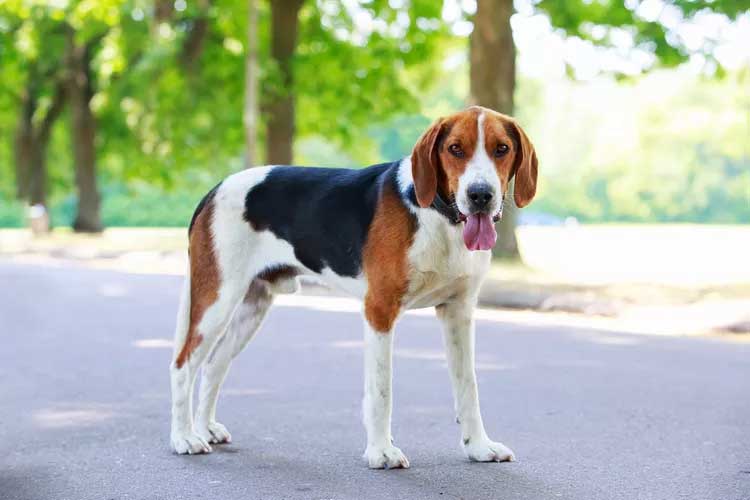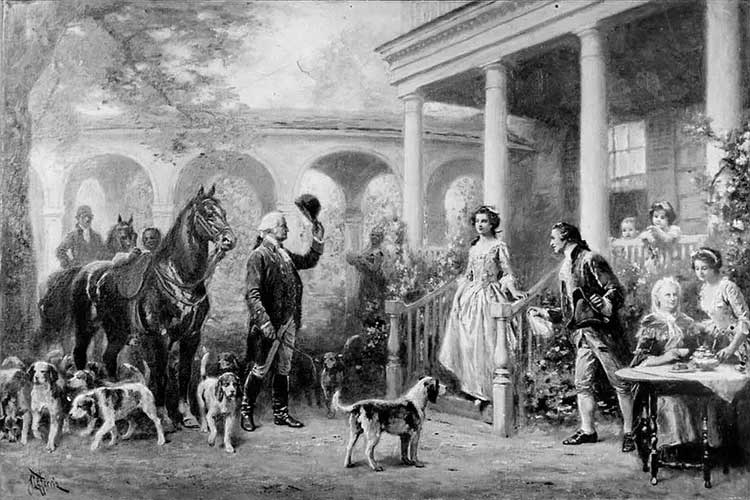One of the first breeds developed in the United States but now exceedingly rare, the friendly American foxhound is an exceptional hunter with a melodious bay that carries for miles.

American Foxhound Overview
| OFFICIAL NAME | American Foxhound |
| COMMON NAME | American Foxhound |
| PET HEIGHT | 21 to 25 inches |
| PET WEIGHT | 60 to 70 pounds |
| LIFESPAN | 11 to 13 years |
| GOOD WITH | children, dogs, families |
| TEMPERAMENT | friendly, gentle, playful, willful |
| INTELLIGENCE | medium |
| SHEDDING AMOUNT | infrequent |
| EXERCISE NEEDS | high |
| ENERGY LEVEL | active |
| VOCAL LEVEL | howler |
| DROOL AMOUNT | low |
| BREED GROUP | hound |
| BREED SIZE | large (61-100 lbs.) |
| COAT LENGTH | short |
| COLORS | black, blue, brown / chocolate / liver, cream, fawn, gold / yellow, gray, red, white |
| PATTERNS | bicolor, tricolor |
| OTHER TRAITS | easy to groom, easy to train, good hiking companion, high potential for weight gain, high prey drive, hot weather tolerant |
The American foxhound is a sweet-natured, medium-sized hound that was one of the very first dog breeds developed in the United States. But that illustrious pedigree doesn't translate into current popularity; in fact, she's one of the rarest breeds in the country.
She's one heck of a hunter, blending speed, endurance, and an unbeatable work ethic. These days, you'll most often find her as a member of a pack in a foxhunting club.
But that doesn't mean she can't make for an exceptional family pet! American foxhounds are loving, loyal, and have a coat that couldn't be easier to care for. Plus, she gets along with the entire family, whether they have two or four legs. She just needs a family that's prepared to provide her with lots of exercise, a home with enough space to safely stretch those long legs, and, ideally, no neighbors to complain about her vocal stylings (because the foxhound is one musical pooch).
Appearance
She's got legs, and the American foxhound knows how to use them! Sleeker and leggier than her cousin, the English foxhound, this is a tall and athletic 60- to 70-pound hound. She has a smooth, hard, medium-to-short coat that can come in any color, according to the breed standard, although she's often a mix of black, white, and tan.
Her tail is a bit heavy with hair; this is called having a "slight brush." Her long, soft ears and large brown or hazel eyes give her a sweet expression that's a window into her gentle soul … until she catches a scent, anyway.
Temperament
Kind and gentle describes the American foxhound temperament. She gets along well with just about everyone, from other dogs to young children and even cats if she's raised with them. But, because of her hunting history, living with small animals can be a challenge for some foxhounds.That social nature means she doesn't appreciate being left alone without canine or human company. And if she gets lonely, she'll be quick to voice her displeasure with a howl that can carry for miles … and maybe with chewing up your home, too.
"Anyone owning a hound needs to be prepared to listen to them howl," says Michael Miller, DVM, co-owner of Lakewood Animal Hospital in Morris, Ill. "Sometimes this can be a very rare occurrence, but some individuals seem to get special pleasure from echoing through the house in the middle of the night. And other dogs have specific noise triggers that can induce an operatic performance."

"American foxhounds can definitely succeed as family pets," says Kayla Fratt, CBDC, dog behavior consultant at Journey Dog Training. "They tend to be very social, affable, cuddly—lots of really good qualities. But people sometimes struggle with remembering what these dogs are bred for, what that looks like, and whether or not that's the life you really want to provide. Maybe you can do it, but are you going to want to train them every day? Run them every day? Because they'll need it."
The qualities that make American foxhounds such exceptional hunters, like their howling and need to exercise, are also what can make them a handful for the unsuspecting owner.
"A lot of hounds are kind of emotional," Fratt says. "When they get excited, they get really excited—and they yell about it. They're bred to take off running and hollering when they catch a scent, and your only job is to keep up. That independence and voice is really important for this breed, and once you get outside, if they catch a scent, you're likely to more or less disappear to them."
Because of their tendency to lock onto a scent, Fratt says, American foxhounds can easily become distracted from their training. Remember, these dogs were bred to be independent, and that can be a big shift for those who are used to training a people-pleaser like a Lab or a border collie, Fratt says.
Living Needs
Even though the American foxhound dog is an old breed, these dogs tend to handle many aspects of modern life really well, Fratt says. They're lovers of children, adults, and other pets, though they can be a little wary of strangers. But socializing your American foxhound puppy from an early age will help her be more comfortable with new people."They're so goofy and they're not generally easily stressed, worried, or scared of things," she says. "They can be great in a chaotic household because those loud, animated discussions aren't likely to be upsetting to a foxhound."
What is upsetting to foxhounds, though, is being lonely and bored—and they're not afraid to voice their booming, baying complaints. A bored or depressed foxhound isn't just noisy, but she can also show her displeasure by finding her own fun around the house, generally in the form of finding things to destroy.

Fortunately, there are loads of fun ways to help your foxhound expend some energy—even if you have no interest whatsoever in hunting. A large, securely fenced yard is a good start, but keep in mind that "secure" is the key word, and a mild deterrent won't be enough to keep her from following a scent.
These dogs have incredible stamina and can run for miles, so they can be excellent hiking or trail running partners, Fratt says, although she cautions against letting them off-leash—they're prone to taking off after a scent. Physically, there's no reason an American foxhound can't take part in dog sports like agility, but because of her distractibility, she's unlikely to be the star student.
Fratt's very favorite activity for foxhounds: Trailing and tracking.
"It's amazing to see that independence, voice, and emotionality come together," she says. "When there are things you maybe find a little annoying about your dog, it's helpful to understand why they do what they do. And here, you see it in action."
Care
When it comes to grooming needs, the American foxhound is as easy as it gets. Give her a once-over with a brush like a rubber mitt every week or so, bathe her if she gets too dirty, and keep her nails trimmed so that they don't clack on the floors. Keep a close eye on her ears, Miller says, especially if she likes to swim or splash around in water, and flush them out after any swimming session with an ear cleaning solution to prevent an ear infection.Food is the way to your foxhound's heart during training, so make sure you use lots of treats and positive reinforcement. Though she's responsive and bright, she's also very easily distracted by scents, which may mean that the cues she's mastered at home seem to fly out the window once you leave the house.
"Be systematic and smart about how you're layering in distractions," Fratt says. And remember that they may not be entirely responsive to your verbal recall cues when outdoors, especially if their attention is focused elsewhere.
Keep an eye—or rather, an ear—on your American foxhound's howling, too. If it's ramping up, it may be worth a conversation with your veterinarian to see if her vocalness is stress-related.
"We have seen advances in the past few years with anti-anxiety options to reduce stress-induced behaviors such as howling," Miller says. "So if your dog is keeping you or your neighbors up at night, please discuss how you can try to reduce your dog's anxiety with your veterinarian."
Health
The American foxhound is a remarkably healthy breed, but not totally resistant to all health issues. Hip dysplasia can be a concern, and other conditions include thrombocytopathy (a platelet disorder) and Pelger-Huet anomaly (a white blood cell disorder).Ear infections are probably the most common concern, Miller says, particularly if your American foxhound loves to go swimming.
"Those floppy ears can trap in moisture and create the perfect environment for yeast or bacteria to grow and create a painful ear infection," he says. "If your foxhound spends time splashing in the water, I would recommend flushing out those ears afterward with an ear cleaning solution to try to prevent an ear infection."
Because she's a hunter who loves to spend time outside, owners should closely monitor their skin and paws for wounds or sores that can happen in the field. If you notice your pup is limping, keep a close eye on it—a paw injury isn't the only cause, particularly in adventurous dogs who can have an injury higher up the leg in a joint or muscle.
"Sometimes these aches and pains after an adventure will go away with rest, but if the limping continues or is exceedingly painful, then the dog should be examined by a veterinarian to determine if a more severe injury has occurred," Miller says.
American foxhounds live 11–13 years. As your hound ages, her energy level may remain high, but she might have a harder time getting around after a big day of running. Miller suggests talking to your vet about whether a joint supplement, special diet, or anti-inflammatory medication could help make her more comfortable in her golden years.
History
Before George Washington became the nation's first president, he was instrumental in developing the American foxhound breed. Washington, an avid houndsman, had a strain of black-and-tan English foxhounds at Mount Vernon believed to have descended from a pack owned by a Maryland-bound settler named Robert Brooke, who arrived in the New World in 1650.
In 1785, in his quest to develop a foxhound more perfectly suited to the vast expanses of the American countryside, he bred his dogs with a pack of enormous hounds of French breeding stock that he received as a gift from an admirer via his friend, the Marquis de Lafayette.
Horses and hounds were an important part of life for wealthy Virginia plantation owners like the Washingtons, and refinements continued to be made to the new breed in post-Colonial times. This led to the modern American foxhound, which is distinctly sleeker, faster, and more independent than his English cousin. The American foxhound later became the basis for some of the later coonhound breeds, including the Treeing Walker coonhound, the American English coonhound, and the bluetick coonhound.
Recognized as a breed by the American Kennel Club in 1886, the American foxhound is one of the rarest registered breeds—and that means finding breeders and American foxhound puppies can take considerable time and effort. She's still seen most frequently in foxhunting packs.
Fun Facts
One of the early breeders of the American Foxhound was none other than George Washington, who kept a pack of hounds at Mount Vernon. Famous American foxhounds owned by Washington include Tipsy, Tipler, and Drunkard, and Washington is quoted as having described the dogs' voices as sounding like "the bells of Moscow," according to the AKC.She may be rare, but the American foxhound has a prominent place as the state dog of Virginia.
Rita Mae Brown's Mrs. Murphy mystery series, which is set in Virginia hunt country, features a number of American foxhound characters.
Wondering about the traits of an American foxhound vs. English foxhound? The main differences are that the American foxhound's legs are longer and more finely boned, and the American's back end is slightly arched.